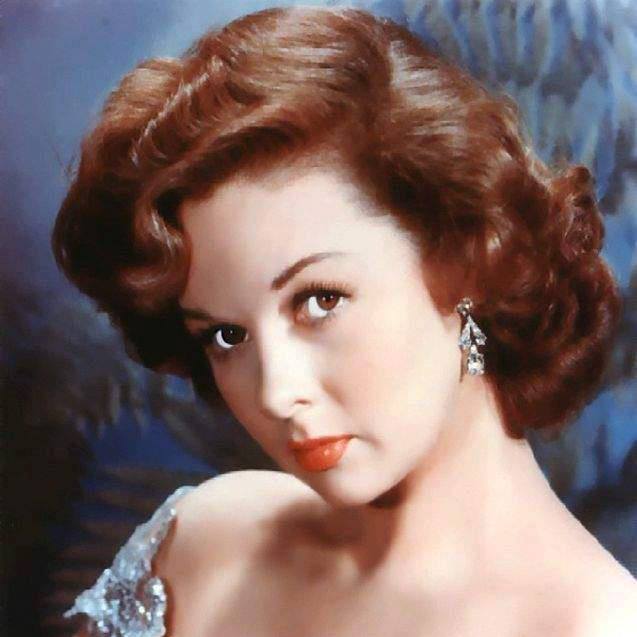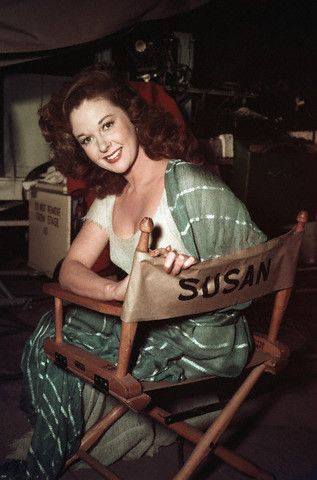
Susan Hayward
Hayward in 1940s Born Edythe Marrenner
June 30, 1917 Brooklyn, New York, U.S.
Died March 14, 1975 (aged 57) Beverly Hills, California, U.S.
Resting place Our Lady of Perpetual Help Cemetery (Carrollton, Georgia)
Nationality American
Education The Girls’ Commercial High School Occupation Actress, model
Susan Hayward (born Edythe Marrenner; June 30, 1917 – March 14, 1975) was an American actress and model. After working as a fashion model, Hayward traveled to Hollywood in 1937. She secured a film contract and played several small supporting roles over the next few years. By the late 1940s, the quality of her film roles had improved, and she achieved recognition for her dramatic abilities with the first of five Academy Award nominations for Best Actress for her performance as an alcoholic in Smash-Up, the Story of a Woman (1947). Her career continued successfully through the 1950s and she received subsequent nominations for My Foolish Heart (1949), With a Song in My Heart (1952), and I’ll Cry Tomorrow (1955). She finally won the Academy Award for Best Actress for her portrayal of death row inmate Barbara Graham in I Want to Live! (1958).
After Hayward’s second marriage and subsequent move to Georgia, her film appearances became infrequent, although she continued acting in film and television until 1972. She died in 1975 of brain cancer.
Hayward was born Edythe Marrenner on June 30, 1917, in the Brooklyn borough of New York City, the youngest of three children born to Ellen and Walter Marrenner. Her paternal grandmother was an actress, Kate Harrigan, from County Cork, Ireland. Her mother was of Swedish descent. She had an older sister, Florence (born May 1910), and an older brother, Walter, Jr. (born December 1911). She was born on the same day, and in the same city, as entertainer Lena Horne. Hayward was educated at Public School 181 and graduated from the Girls’ Commercial High School (later renamed Prospect Heights High School). According to the Erasmus Hall High School alumni page, Hayward attended that school in the mid-1930s, so she possibly attended Erasmus Hall High School before transferring to Girls’ Commercial High School. During her high school years, she acted in various school plays, and was named “Most Dramatic” by her class. She graduated in June 1935.
Hayward had small bits in Hollywood Hotel (1937), The Amazing Dr. Clitterhouse (1938) (her part was ultimately deleted), and The Sisters (1938), as well as a short, Campus Cinderella (1938). Hayward’s first sizeable role was with Ronald Reagan, in Girls on Probation (1938). She was also in Comet Over Broadway (1938).
Paramount
Hayward went to Paramount, where she had her first breakthrough: the part of Isobel in Beau Geste (1939) opposite Gary Cooper and Ray Milland. Although only a small role it was the largest female part and the film was hugely successful. Paramount put Hayward as the second lead in Our Leading Citizen (1939) with Bob Burns and she supported Joe E. Brown in $1000 a Touchdown (1939). Hayward went to Columbia to support Ingrid Bergman in Adam Had Four Sons (1941) then to Republic for Sis Hopkins (1941) with Judy Canova and Bob Crosby. Back at Paramount she had the lead in a “B”, Among the Living (1941). Cecil B. De Mille gave her a good support role in Reap the Wild Wind (1942), as the second lead with Milland, John Wayne and Paulette Goddard. She was in a short A Letter from Bataan (1942) and supported Goddard and Fred MacMurray in The Forest Rangers (1942).
United Artists and Republic
Hayward was the false love interest in I Married a Witch (1942) with Frederic March and Veronica Lake, made for Paramount but sold to United Artists. She was one of many stars in Star Spangled Rhythm (1943). Hayward was in Young and Willing (1943) with William Holden, another Paramount film distributed by UA. She was in Republic’s Hit Parade of 1943 (1943), her singing voice dubbed. Sam Bronston borrowed her for Jack London (1943) at UA then she was Wayne’s love interest in The Fighting Seabees (1944) at Republic, the biggest budgeted film in that company’s history.[4] She starred in the film version of The Hairy Ape (1944) for UA. Back at Paramount she was Loretta Young’s sister in And Now Tomorrow (1944). She then left the studio. RKO gave Hayward her first top billed role in Deadline at Dawn (1946), a “B” film which was Harold Clurman’s only movie as director.

After the war, Hayward’s career took off when she was contracted by producer Walter Wanger for a seven-year contract at $100,000 a year.[5] with her first film being Canyon Passage (1946). In 1947, she received the first of five Academy Award nominations for her role as an alcoholic nightclub singer based on Dixie Lee in Smash-Up, the Story of a Woman, her second film for Wanger. It was a success and launched Hayward as a star.[6] RKO used her again for They Won’t Believe Me (1947) then she worked for Wanger on The Lost Moment (1948), and Tap Roots (1948); both films lost money but the latter was widely seen. At Universal she was in The Saxon Charm (1948) and she did Tulsa (1949) for Wanger. Both films were commercial disappointments.
20th Century Fox
Hayward went over to 20th Century Fox to make House of Strangers (1949) for director Joseph Mankiewicz, beginning a long association with that studio. Sam Goldwyn borrowed her for My Foolish Heart (1949), then she went back to Fox for I’d Climb the Highest Mountain (1951), which was a hit.[8] She stayed at that studio to make Rawhide (1951) with Tyrone Power, and I Can Get It for You Wholesale (1951). Hayward then starred in three massive successes: David and Bathsheba (1951) with Gregory Peck, the most popular film of the year;[9] With a Song in My Heart (1952), a biopic of Jane Froman, which earned her an Oscar nomination; and The Snows of Kilimanjaro (1952), with Peck and Ava Gardner. RKO borrowed Hayward for The Lusty Men (1952) with Robert Mitchum then she went back to Fox for The President’s Lady (1953), playing Rachel Jackson alongside Charlton Heston; White Witch Doctor (1953), with Mitchum; Demetrius and the Gladiators (1954), as Messalina; Garden of Evil (1954) with Gary Cooper and Richard Widmark; Untamed (1955) with Power, and Soldier of Fortune (1955) with Clark Gable.
MGM hired her to play the alcoholic actress Lillian Roth in I’ll Cry Tomorrow (1955), based on Roth’s best-selling autobiography of the same name, for which she received a Cannes award. It was a major financial success. Although Hayward never truly became known as a singer because she hated her own singing, she portrayed singers in several films. However, in I’ll Cry Tomorrow, though a “ghost singer” was actually recruited, Hayward’s own voice is actually heard on the soundtrack. Susan Hayward performed in the musical biography of Jane Froman in the 1952 film, With a Song in My Heart, a role which won her the Golden Globe for Best Actress Comedy film. Jane Froman’s voice was dubbed as Hayward acted out the songs.
In 1956, she was cast by Howard Hughes to play Bortai in the historical epic The Conqueror, as John Wayne’s leading lady. It was critically reviled but a commercial success. She did a comedy with Kirk Douglas, Top Secret Affair (1956) which flopped. Hayward made one more film with Wagner, I Want to Live! (1958), playing Barbara Graham, which was a critical and commercial success. Hayward won the Best Actress Oscar for her performance and was also entitled to 37% of the film’s profit.
Hayward made Thunder in the Sun (1959) with Jeff Chandler and Woman Obsessed (1959) at Fox. In 1961, Hayward starred as a working girl who becomes the wife of the state’s next governor (Dean Martin) and ultimately takes over that office herself in Ada. The same year, she played Rae Smith in Ross Hunter’s lavish remake of Back Street, which also starred John Gavin and Vera Miles. Neither of these films were particularly successful; neither were I Thank a Fool (1963) at MGM, Stolen Hours (1963), and Where Love Has Gone (1964).
Personal life
Hayward was married to actor Jess Barker for 10 years and they had two children, fraternal twin sons named Gregory and Timothy, born February 19, 1945. The marriage was described in Hollywood gossip columns as turbulent. They divorced in 1954. Hayward attempted suicide after the divorce. During the contentious divorce proceedings, Hayward stayed in the United States rather than join the Hong Kong location shooting for the film Soldier of Fortune. She shot her scenes with co-star Clark Gable indoors in Hollywood. A few brief, distant scenes of Gable and a Hayward double walking near landmarks in Hong Kong were combined with the indoor shots.
In 1957, Hayward married Floyd Eaton Chalkley, commonly known as Eaton Chalkley. He was a Georgia rancher and businessman who had formerly worked as a federal agent. Although he was an unusual husband for a Hollywood movie star, the marriage was a happy one. She lived with him on a farm near Carrollton, Georgia. The couple also owned property across the state line in Cleburne County, just outside Heflin, Alabama. She became a popular figure in an area that in the 1950s was off the beaten path for most celebrities. In December 1964, she and her husband were baptized Catholic by Father McGuire at SS Peter and Paul’s Roman Catholic Church on Larimer Avenue, in the East Liberty section of Pittsburgh. She had met McGuire while in China and promised him that if she ever converted, he would be the one to baptize her. Chalkley died on January 9, 1966. Hayward went into mourning and did little acting for several years, and took up residence in Florida, because she preferred not to live in her Georgia home without her husband. Before her Catholic baptism, Hayward was a proponent of astrology.[20] She particularly relied on the advice of Carroll Righter, who called himself “the Gregarious Aquarius” and the self-proclaimed “Astrologer to the Stars”, who informed her that the optimum time to sign a film contract was exactly 2:47 am, causing her to set her alarm for 2:45 so she could be sure to obey his instructions. Hayward was a lifelong registered Republican, who endorsed Dwight D. Eisenhower in 1952 and appeared at the 1953 Republican Rally.
Death Hayward was diagnosed with brain cancer in 1973. On March 14, 1975, she suffered a seizure in her Beverly Hills home, and died at the age of 57. A funeral service was held on March 16 at Our Lady of Perpetual Help Roman Catholic Church in Carrollton, Georgia. Hayward’s body was buried in the church’s cemetery. Hayward may have developed cancer from radioactive fallout from atmospheric atomic bomb tests, while making The Conqueror with John Wayne in St. George, Utah. Several production members, as well as Wayne himself, Agnes Moorehead, Pedro Armendáriz (who committed suicide), and its director, Dick Powell, later succumbed to cancer and cancer-related illnesses. The cast and crew totaled 220 people. By the end of 1980, as ascertained by People, 91 of them had developed some form of cancer, and 46 had died of the disease. Susan Hayward has a star on the Hollywood Walk of Fame, at 6251 Hollywood Boulevard.
From Wikipedia, the free encyclopedia
